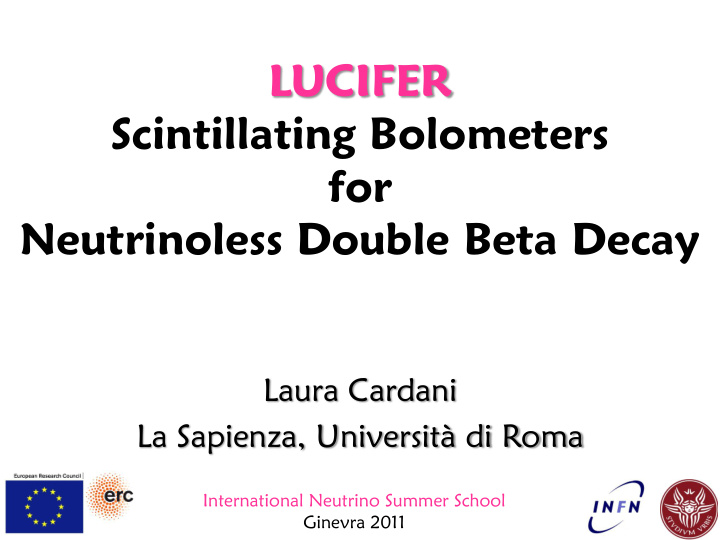



LUCIFER Scintillating Bolometers for Neutrinoless Double Beta Decay Laura Cardani La Sapienza, Università di Roma International Neutrino Summer School Ginevra 2011
The goal of the project The goal of LUCIFER is the study of the neutrinoless double beta decay DBD(0 ). - Why is this decay so important? e - W DBD(0 ) can happen only if neutrinos are • v Majorana particles! If seen, we could give an estimation on the • - v absolute effective mass of this particle: W - e -
The goal of the project The goal of LUCIFER is the study of the neutrinoless double beta decay DBD(0 ). - Why is this decay so important? e - W DBD(0 ) can happen only if neutrinos are • v Majorana particles! If seen, we could give an estimation on the • - v absolute effective mass of this particle: W - e - What are we looking for? If we plot the sum of the energies of the two e - v we expect a monochromatic peak at the Q-value of the decay. -
The goal of the project The goal of LUCIFER is the study of the neutrinoless double beta decay DBD(0 ). - Why is this decay so important? e - W DBD(0 ) can happen only if neutrinos are • v Majorana particles! If seen, we could give an estimation on the • - v absolute effective mass of this particle: W - e - What are we looking for? If we plot the sum of the energies of the two e - v we expect a monochromatic peak at the Q-value of the decay. - What do we need? • Excellent energy resolution • Large source mass • Very low background level main challenge!
The detection technique Bolometers are ideal surveys for these purposes. A particle interaction in the crystal causes a temperature increase. The temperature increase can be transformed in a voltage variation by means of proper sensors. Main advantages: • They can be grown with most of the interesting emitters • Large source mass; • Radio-purity • Energy resolution ( ≈ 5 keV in the region of interest)
The detection technique Bolometers are ideal surveys for these purposes. A particle interaction in the crystal causes a temperature increase. The temperature increase can be transformed in a voltage variation by means of proper sensors. If the crystal scintillates, a further background suppression can be achieved by means of the scintillation light read- out. events, indeed, emit more light with respect to events. Therefore, we expect the two different events to lie on different bands in the light vs heat scatter plot.
The detection technique Bolometers are ideal surveys for these purposes. A particle interaction in the crystal causes a temperature increase. The temperature increase can be transformed in a voltage variation by means of proper sensors. If the crystal scintillates, a further background suppression can be achieved by means of the scintillation light read- out. events, indeed, emit more light with respect to events. Therefore, we expect the two different events to lie on different bands in the light vs heat scatter plot. Research Proposal (B1) LUCIFER 2009 Only background!!
The choice of the isotope But background can be suppressed by an intelligent choice of the isotope: 208 Tl Research Proposal (B1) LUCIFER 2009
The choice of the isotope But background can be suppressed by an intelligent choice of the isotope: Unfortunately, the emitters with highest Q- value have a low isotopic abundance. In order to perform a large mass experiment, we need to compromise among the following requests: • Q-value • Isotopic Abundance (enrichment?) • Possibility of growing scintillating crystals
The R&D Activity Q-value Useful LY QF [keV] material [keV/MeV] CdWO 4 2809 32% 17.6 0.19 ZnMoO 4 3034 44% 1.4 0.16 ZnSe 2995 56% 7.4 4.2 A study of the most interesting crystals was performed (and the R&D is still on-going). The most promising candidate looks 82 Se ZnSe scintillating bolometers.
The detector The LUCIFER detector will be a tower of ZnSe crystals and light detectors. The array will be operated in a 3 He/ 4 He cryostat in the underground LNGS (Italy)
The achieveable sensitivity The LUCIFER detector will be a tower of ZnSe crystals and light detectors. The array will be operated in a 3 He/ 4 He cryostat in the underground LNGS (Italy) Assuming: Sensitivity that we could reach with ZnSe bolometers: T = 5 y 1000 crystals @ 95% b = 10 -3 counts/keV/kg/y E = 5 keV 52 crystals @ 95% a.i. = 95% M = 31.7 kg (17.6 kg 82 Se) 1000 crystals no enrichment 52 crystals no enrichment NME = J.Mendez et al. arXiv:0801.3760; F.Simkovic et al. Phys.Rev. C77 (2008); J.Suhonen et al. Int.J.Mod.Phys E17 (2008 ) S. Sangiorgio presentation @ NuMass Seattle 2010 This sensitivity corresponds to a limit on the effective neutrino mass of 52-65 meV Inverse mass hierarchy!
Conclusions: • Due to the rarity of the process, the experimental search of DBD0v is a great challenge; • One of the key goals is the background reduction, that LUCIFER will fulfill with the heat-light double read-out; • With such a low background counting rate, LUCIFER will be able to compete with the next generation experiments. • Data taking foreseen in 2014 … stay tuned
• • Heat – Light coincidence signal
Recommend
More recommend